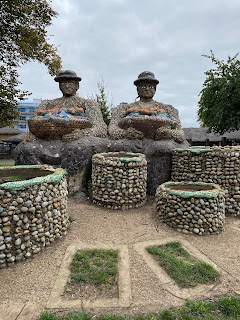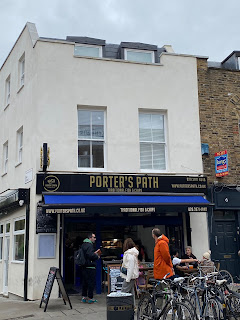The Black path is a trail from Walthamstow to Shoreditch done justice in these two links Spittlefields Life. The route of this medieval footpath is visible through street markets, shop and road names. There is no formal map of the Black path, yet a keen walker with a sense of direction, willing to make a few twists and turns, through several welcome green spaces, will find their way.
Tracing a trajectory running northeast and southwest between Shoreditch Church and the crossing of the River Lea at Clapton, the Black Path links with Old Street in one direction and extends beyond Walthamstow in the other.
Sometimes called the Porter’s Way, this was the route cattle were driven to Smithfield and the path used by smallholders taking produce to Spitalfields Market. Sometimes also called the Templars’ Way, it links the thirteenth century St Augustine’s Tower on land once owned by Knights Templar in Hackney with the Priory of St John in Clerkenwell where they had their headquarters.
This is my walk: -
Begin at the Walthamstow bus station at the end of the Victoria line and head for the market - a fruit forest - on the High St.
Plenty of places for a short rest and a sandwich in one of the parklets along Coppermill road. Admire the street art and opportunities for diversions in some of the community buildings, such as The Mill, where I bought a hand - knitted cardigan for one of the twins. There is a most welcome toilet inside.
Sharp left into James' Street: - a smell of hash and people getting haircuts. Griffins in the pavement and interesting murals on house walls . New flats are not too high .
Markhouse Road E17: - Overshot, should have turned right sooner, path not quite as intuitive for a stranger to the area. How did it get to 2pm? Mr Dench Gym and Fitness has taken their gym equipment outside, smart move.
Approach Low Hall Lane (I undertook bat surveys here for the council many years ago and badgers showed up on the security cameras). The sun hits the top of the London Lighthouse building, which I try to capture with my camera, but ironically there is insufficient light. Established in 1893 it is now a Methodist Church.
Smell of chipped bark along Verulum Ave as a new school street is implemented from 4.10.21. Waltham Forest proudly announce '15 school streets with 12,000 beneficiaries'.
St Saviours Church grabs my attention and I explore the churchyard even though this is a diversion from the route through the industrial estate. Amusement at the 'Barking' signpost, which has been slightly turned towards the Vicarage and the fox has had a field-day with the vicar's shoes.
Pleasure at the mature limes, cedars and oak: a newly planted yew MAZE is quite a feature (see below). There are some fungi treasures also with glistening ink caps and cavalier mushrooms (Melanoleuca melanoleuca).
Baby maze St Saviours churchArgall Way: - I pick up the route on Lea Bridge Road where I am on familiar territory having led bat walks and undertaken surveys at many of the green spaces here over the years.
I peep through the security fencing of a culvert - an Environment Agency assett - to see that it is full of Himalayan balsam. Love your terraces with your brick arches along here.
The footpath around Lee Valley Park is diverted because of the building of the ice rink. I find it hard to articulate the disbelief when I see the hoardings and that we are still allowing unnecessary building on open land in this day and age, especially near a floodplain.
Old River LeaHoardings where the new ice rink will be sited
Cross by the sluice where there is lots of floating pennywort
Turn sharp left by the pub and into Millfields park where a someone is having fun cycling through puddles. I ask if I could take their photo. It was much deeper than it looks here. There is a lot of conservation work going on in the park I noticed, there has been tree planting and a relaxing of the mowing in places.
Powerhouse road: - was long so I called it a day -caught the bus to Finsbury Park station- and returned the following weekend. At some stage I entered Hackney and St. Augustines Tower, where years ago there was a super - colony of house sparrows, although there is no sign of them today. They used to congregate in a Russian vine that grew over the wall. There is a tiny bit of grass and a sea of paths and a dead 'splash pad', courtesy of some Lottery grant (I seem to remember).
London Fields: - the statue of the Porter, locals call them 'flower sellers', echoes of the drove road in street names such as Lamb Lane. A favourite climbing place for local children on the backs of the Porters and the highlight of the walk.
The Broadway market was great for food and I had a vegan brownie and bought a friend an Xmas present. 'Porters Path' its in the Fish and Chip shop name










Comments
Post a Comment